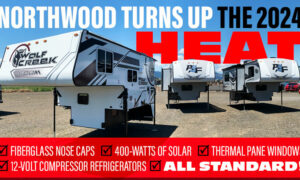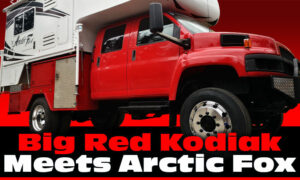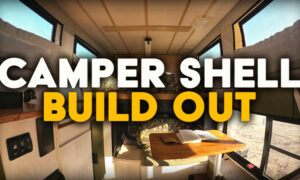Life long beach camper Mike Layton walks us through the basics of truck camping on the beach. It’s time to air down, take it slow, and point the truck to the ocean waves.

Mike Layton has been beach camping in a truck camper since he was five years old. In the early 1970’s, his would take him out to Assateague Island National Seashore in their Six-Pac truck camper. Mike told us that he couldn’t wait to get to the beach so he could sit on his father’s lap and drive. As he got older, Mike started helping his father with the beach camping and soon his father was just watching to make sure Mike was doing things right. Today, Mike is passing on the knowledge his father showed him.
 |  |  |
Beach Camping 101
by Mike Layton
If you have never been on a particular beach, I strongly recommend researching that specific beach before you go. For example, in Florida you can drive a car on the beach because the sand is like concrete. But in Maryland, you need a four-wheel drive vehicle because the sand is extremely soft.
You also need to know what equipment you will need on the beach. I recommend that you call the beach visitor’s center to get information and the beach rules so that you don’t get in trouble with anything. Of course I also strongly recommend that you know your vehicle and it’s capabilities as much as possible.
I’ve found that Assateague Island National Seashore is one of the most challenging beaches to drive on. It’s a federally owned park and the rangers are strict. Other beaches are not as particular.
Most of the information I will give you is about driving on Assateague, but most of this information should apply to other beaches that you want to truck camp on.
 |  |  |
Driving on the Beach
Sand differs at every beach. Down in North Carolina, the sand is soft on the top and harder underneath. In Maryland, the sand is soft and deep. You need to know what kind of conditions you are facing before putting your vehicle on the sand.
On Assateague, you are not allowed to have dual rear wheel trucks. You must have a single rear wheel vehicle. If you have a dually, you can take the outside wheels off so that you can drive on the beach. This is not a rule at all beaches.
Since I’ve been a mechanic for many years, I know how the drive train, the engine, and the transmission work. With all the weight of your camper on the back of the truck, it is quite a load. In fact, you’ll only get about four miles per gallon when driving on the sand, so make sure you have a full tank of fuel before hitting the sand.
My advice is to put your transfer case in four-wheel drive low anytime you are driving on the beach. It makes the engine work less and helps keep the transmission and engine from overheating. Also, the speed limit on Assateague is twenty-five miles per hour on the beach. I go fifteen miles per hour, at best, with the camper on the truck. Because of the ruts, you will have sway and rocking when driving on the beach. Go slow. And if somebody is parked, slow down.
If you have to change lanes on the beach, you should slow down to five miles per hour. The ruts can be deep. When you turn your wheel, it doesn’t want to come out of the ruts right away. When your back wheels go across the ruts, you should be extremely slow. As you going into the next rut, it will make you rock. If you are not slow enough, you could flip your truck camper.
When driving on the beach you may want to stay aligned with the ruts because it’s easier on your vehicle. At Assateague, if you are traveling south you have the right of way. The ocean side has to give when you come face to face. That’s when you would have to change lanes, which means you have to move a couple of sets of ruts over.
Tires
Any type radial tire will work when you drive on the beach. I’ve had mud tires and all-terrain tires. As long as it’s a radial tire, it will belly out when you take out the air and float on the sand.
Here in Maryland, 19.5”, like Rickson wheels and tires, are not good on the beach. 19.5” tires are so thin that you can’t get a belly out of them. They want to roll right off the rim. They are made more for the road, but not for the beach.
 |  |  |
Airing Down Your Tires
You need to air down your tires to prevent becoming stuck in the sand. Imagine your tire is like a bowling ball. In the sand, it would drag. When you air down your tires, they are more like balloons. You want your tires to be like balloons and float on top of the sand.
To air down your tires, you could get something called an Air Buddy. You set it for the pressure that you want. You can also air down the old fashioned way using an air gauge. This way, you would check where the pressure is at, push on the stem, and keep checking gauge until you get to the pressure you need.
The recommended pressure for driving on the beach varies from beach to beach. In North Carolina I used twenty-five pounds in the front and I used forty-five pounds in the back.
On Assateague, I use twenty pounds in the front tires (maybe eighteen) and thirty-five pounds in the back. Don’t use less pressure unless you are a really small camper. Make sure you watch the belly of the tire as you let the air out.
If you air down too little you will feel a lot of drag. It will feel like your tires want to spin. Then you’ll know to stop and let out more air. If you air down too much, your tire will look way too slack. Letting too much air out could pop the tire away from the rim possibly causing a flat tire.
 |  |  |
Tools and Equipment For the Beach
When you travel on the beach, you need to have equipment in your rig to help you if you get into a bind. The rangers will periodically inspect campers to make sure that you have required equipment. You should have:
1. A shovel that has a six-inch square blade with a handle is that is minimum of eighteen-inches long. I have a full round point shovel on my truck because it penetrates the sand better.
2. A sufficient vehicle jack. Your jack has to be able to lift one wheel off the sand. Most of the time, the jack that comes with your truck will be sufficient.
3. Tow ropes or tow straps that can pull the weight of your rig. My rope is one and a half inches thick and fifty-feet long. I do not recommend a chain or cable because it could break and really hurt someone.
4. A tire gauge that can read a minimum of fifteen-pounds, or less. There are LED read-out tire gauges that are really nice. Once I had one and the battery died, so now I keep two or three in the truck.
5. A twelve-by-twelve non-bending metal or 5/8-inch wood plate. This would go on the sand for your camper jacks to sit on. That’s why it is so important to have a 5/8-inch thick block of wood. I have ½-inch thick aluminum plates.
6. A spare Tire. A spare tire is a requirement on the beach.
7. All tanks should work properly. The rangers will make sure that you have proper grey and black holding tanks.
It’s not essential, but recommended is to bring bug spray. When the wind blows off the ocean and into the bay, you will have mosquitoes on the bay side, but if wind shifts from the bay to the ocean, you will get eaten by the bugs.
Also, bring trash bags because you have to take the trash off the beach with you. There are dumps when you leave, but none on the beach. You should also bring food and plenty of water. I even carry a bladder tank that carries forty-five gallons of extra water for when we have a three-day weekend.
Getting Stuck in the Sand
The biggest problem people have is that they don’t take enough air out of their tires or something happens when they’re not in four-wheel drive.
Another piece of advice I have is to not let your tires spin on the sand. If they do, you will sink. If you get into deep sand, and don’t let the proper amount of air out of your tires prior to going on the beach, your tires will spin. You need to go and check your tires. More likely than not you are going to have to let more air out. Again, make sure you watch the belly of the tire as you let the air out.
One time I did get stuck in the sand. It was my fault. I had a new set of tires and left forty-five pounds in the tire on the back because I was scared to air down too much with the weight. It was in powder like sand and I just got stuck. I let my tires down to thirty-five pounds and I haven’t had a problem since.
Helpful Beach Camping Community
I can tell you that if someone broke down or got stuck, four out of the five of the truck campers driving by would stop and help. The people who are in truck campers are experienced enough to know what to do in the sand and guide someone who gets stuck.
Every two or three times I go to the beach, I see a vehicle that’s overheated, broken down, or stuck. Fortunately, people who own campers carry a lot of water to cool the engines and are willing to help out.






























